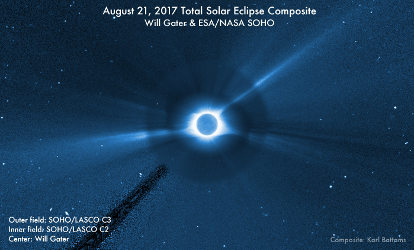Combining Total Solar Eclipses (August 22, 2017)
On August 21st 2017, millions of people across North America were held transfixed as the Moon passed across the face of Sun, briefly blocking its blinding sunlight, and for just a couple of short minutes, revealing the Sun's brilliant outer atmosphere (corona). From Earth, such events are both rare and spectacular, and allow not only the public to see the Sun's corona, but also allow scientists to get a detailed look at the corona very close to the Sun.
In space, however, a solar eclipse is not necessarily a rare thing. In fact for the joint ESA/NASA Solar and Heliospheric Observatory (SOHO), a total solar eclipse is not only common, it's constant, and has been since the spacecraft launched in 1995. We are of course, referring to the US Naval Research Laboratory's (NRL) Large Angle Spectrometric Coronagraph (LASCO) instrument, which is a coronagraph telescope that creates a perpetual total solar eclipse by blocking sunlight with a solid central "occulting" disk, and thus revealing the Sun's much fainter corona.
In this composite image made by NRL scientist Karl Battams, we see the combination of two eclipses: SOHO/LASCO's perpetual eclipse, and the total solar eclipse of August 21. The inner-most image is a stunning ground based shot recorded by UK astrophotographer Will Gater during totality, where not only can we see the very fine-structure detail of the Sun's corona close to the solar disk, but also we see the face of the Moon partially illuminated by "Earth-shine" (sunlight reflected by Earth on to the Moon). This inner image has been combined with two images recorded by SOHO/LASCO, which is able to see solar structures extending far from the Sun, but unable to see fine structure close to the Sun.
The ability to combine concurrent ground and space-based observations of the Sun's corona is a valuable scientific tool that enables solar physicist to better understand how the extended solar corona connects to the features seen near the disk of the Sun, and helps us understand the Sun's extremely complex magnetic fields that control the structure of the Sun's corona.
SOHO began its Weekly Pick some time after sending a weekly image or video clip to the American Museum of Natural History (Rose Center) in New York City. There, the SOHO Weekly Pick is displayed with some annotations on a large plasma display.
If your institution would also like to receive the same Weekly Pick from us for display (usually in Photoshop or QuickTime format), please send your inquiry to steele.hill@gsfc.nasa.gov.



